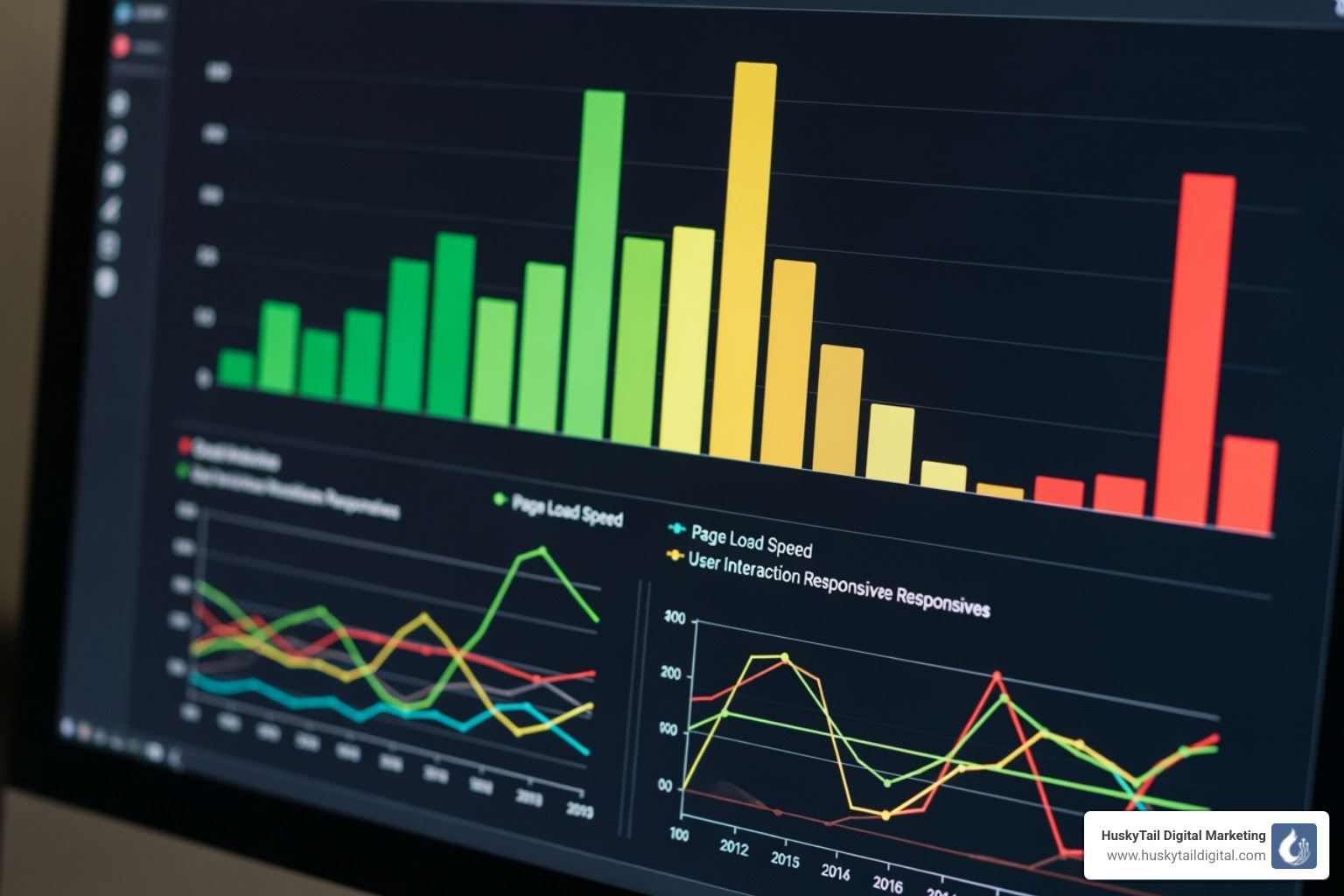Why Technical SEO Is the Foundation of Search Success
Technical SEO is the practice of optimizing your website's infrastructure so search engines can efficiently crawl, index, and understand your content, while also ensuring a fast, secure, and mobile-friendly user experience.
At its core, technical SEO covers three key areas:
- Crawlability and Indexing: Ensuring search engines can find and store your pages.
- Site Performance: Optimizing page speed, mobile-friendliness, and Core Web Vitals.
- Security and Structure: Implementing HTTPS, structured data, and clean site architecture.
Unlike on-page SEO (content and keywords) or off-page SEO (backlinks and authority), technical SEO addresses the backend elements that allow your site to function in search. Without a solid technical foundation, even the best content and backlinks won't deliver the visibility your business deserves.
Why does this matter? A majority of website traffic comes from organic search. If Google can't crawl your site, your pages load slowly, or mobile users have a poor experience, you're losing traffic and revenue to competitors.
Technical SEO is measurable, fixable, and delivers compounding returns. I've seen how addressing crawl budget issues, fixing redirects, and optimizing Core Web Vitals can produce dramatic traffic lifts. For one client, a structured technical SEO overhaul doubled organic traffic in under 90 days by resolving indexing conflicts and improving site speed.
I'm Stephen Gardner, founder of HuskyTail Digital Marketing. For over 20 years, I've built technical SEO strategies that drive measurable growth. My approach blends data-driven audits, AI-improved optimization, and hands-on implementation to ensure your site performs at its peak for both search engines and users.

The Foundation: How Search Engines Crawl and Index Your Site
For a search engine to rank your site, it must first find, understand, and store your pages. This process of crawling, indexing, and rendering is where technical SEO begins.
- Crawling: Search engine bots (like Googlebot) follow links to find content on the web.
- Indexing: After crawling, search engines analyze and store the content in a massive database. If a page isn't indexed, it can't appear in search results.
- Rendering: Google views your page as a user would in a browser. This is crucial for sites using JavaScript, as content loaded via JavaScript might be indexed with a delay, or not at all.
Crawl budget is the finite amount of resources search engines allocate to crawl your site. Wasting this budget on low-value pages can cause your important content to be overlooked. The shift to mobile-first indexing means Google primarily uses the mobile version of your site for indexing and ranking. With over 60% of web traffic coming from mobile, your mobile experience is critical for visibility and ties directly into page experience signals. For more on how AI impacts these elements, see our guide on AI-Powered SEO Strategies.
Optimizing for Crawlability
Making your content accessible to bots is the first step to search visibility.
- Site Architecture: A logical structure, like a silo structure that groups related content, helps search engines understand your content hierarchy and expertise.
- Internal Linking: Linking between your own pages distributes authority, guides users, and reinforces your site structure.
- XML Sitemap: This file acts as a roadmap, listing all URLs you want search engines to find. It's a critical source for URL findy.
- Robots.txt: This file tells bots which parts of your site to avoid. Used correctly, it manages crawl budget; used incorrectly, it can block your entire site from being indexed. Monitor it with Google Search Console's Crawl Stats report.
- URL Structure: Clean, descriptive URLs (e.g.,
yoursite.com/services/technical-seo) are better for both users and search engines than messy URLs with parameters.
Ensuring Proper Indexing
Once crawled, your pages must be indexed correctly.
- Duplicate Content: Identical content on multiple URLs confuses search engines and dilutes link equity. Use canonical tags (
rel="canonical") to specify the main version of a page. Google's guide on canonical URLs explains this in detail. - Noindex Tag: Use this tag to prevent specific pages, like thank-you pages or internal search results, from being indexed.
- 301 Redirects: When a URL changes permanently, a 301 redirect sends users and search engines to the new location, preserving link equity. This is vital during site migrations.
- URL Inspection Tool: This Google Search Console tool is invaluable for checking a page's indexing status and diagnosing issues.
- Broken Internal Links: These waste crawl budget and create a poor user experience. Fix them promptly and use a helpful 404 page to guide users who land on a broken link.
Core Pillars of Technical SEO Performance
Technical SEO is about more than being found; it's about delivering an experience that engages users. Google rewards sites that load quickly, work flawlessly on mobile, and protect user data. These performance pillars—page speed, mobile-friendliness, and security—have been ranking factors for years and are essential for success.
For businesses using WordPress, our WordPress Management services ensure these foundational elements stay optimized.
Mastering Page Speed and Core Web Vitals
A slow website drives users away and hurts conversions. Google's Core Web Vitals (CWV) are metrics that measure real-world user experience and directly influence rankings.

- Largest Contentful Paint (LCP): Measures loading performance. Aim for 2.5 seconds or less.
- Interaction to Next Paint (INP): Measures interactivity. Aim for under 200 milliseconds.
- Cumulative Layout Shift (CLS): Measures visual stability. Aim for a score of 0.1 or less.
To improve these scores, we focus on:
- Image Compression: Using modern formats like WebP to reduce file sizes without quality loss.
- Minifying CSS and JavaScript: Stripping out unnecessary code to create leaner files.
- Browser Caching: Storing files locally on a user's device for faster repeat visits.
- Content Delivery Network (CDN): Serving content from servers close to the user to reduce load times.
Use Google's PageSpeed Insights tool to analyze your site and get specific recommendations.
Mobile-First: Ensuring Mobile-Friendliness and Accessibility
With Google's mobile-first indexing, your mobile site's performance determines your rankings for all devices. A poor mobile experience will cripple your entire SEO strategy.
Responsive web design, which automatically adapts your site to any screen size, is Google's recommended approach. Key elements for mobile usability include:
- Viewport Tag: Ensures your page scales correctly on mobile devices.
- Legible Font Sizes: Use at least 16px for body text so users don't have to zoom.
- Sufficient Tap Targets: Make buttons and links large enough (at least 44x44 pixels) to be easily tapped.
Use Google's Mobile-Friendly Test to check your pages. Furthermore, web accessibility (following WCAG guidelines) not only helps users with disabilities but also improves your technical foundation with cleaner code and a better experience for everyone.
Security and Trust: The Role of HTTPS
Browsers warn users about "Not secure" websites, which destroys trust and conversions. HTTPS encrypts data between your site and its visitors, protecting sensitive information.
Enabled by an SSL/TLS certificate, HTTPS has been a ranking signal since 2014. It's a clear signal of trust and professionalism. Migrating from HTTP to HTTPS requires implementing 301 redirects for all URLs and configuring security headers to prevent duplicate content and add protection.
If your site is still on HTTP, making the switch is a non-negotiable step for building user trust and improving your SEO.
Advanced Technical SEO: Enhancing Visibility and Future-Proofing
Beyond the fundamentals, advanced technical SEO tactics like structured data and AI optimization help future-proof your site. Even a strong Link Building campaign is wasted if backlinks point to pages that search engines can't properly understand.
Speaking the Search Engine's Language with Structured Data
Structured data (or schema markup from schema.org) is code that explicitly tells search engines what your content is about. This helps you earn rich results—improved search listings with elements like star ratings, FAQs, or product prices.

Google prefers the JSON-LD format because it's clean and easy to implement. While not a direct ranking factor, structured data can dramatically improve click-through rates by making your listing stand out. For example, FAQ schema can create expandable snippets in search results, while Product schema displays price, availability, and reviews. Refer to Google's guide to structured data for implementation details.
The Impact of AI on Technical SEO
AI is reshaping search, making technical SEO more critical than ever. Google's AI Overviews and other AI systems understand context, not just keywords, making a technically sound site with clear data signals invaluable.
- JavaScript Rendering: Many AI crawlers struggle with or ignore content loaded via client-side JavaScript. Use server-side rendering (SSR) or static site generation (SSG) for critical content to ensure it's visible in the initial HTML.
- Semantic HTML: Using proper HTML5 tags (
<article>,<nav>, etc.) instead of generic<div>tags gives AI clear signals about your content's structure and purpose.
AI is also sensitive to low-quality content and can sometimes "hallucinate" non-existent URLs. We monitor for these and use 301 redirects to capture potential traffic. Sites that master technical fundamentals will thrive in the AI era. For more strategies, explore our AI SEO resources.
Auditing and Maintenance: A Proactive Approach
Technical SEO is never "done." Websites are dynamic, and issues constantly arise. A proactive approach to auditing and maintenance is essential to prevent small problems from causing major traffic loss.
Essential Technical SEO Audits and Tools
Regular technical SEO audits act as an early warning system. We recommend a comprehensive audit quarterly, with monthly health checks on critical metrics. HuskyTail Digital Marketing offers comprehensive SEO Audits custom to your needs.
Essential tools include:
- Google Search Console (GSC): A free, vital tool for monitoring indexing, crawl errors, Core Web Vitals, and mobile usability. The Crawl Stats report shows how Googlebot interacts with your site.
- Screaming Frog SEO Spider: A crawler that flags broken links, redirect chains, duplicate content, and other technical issues.
- Ahrefs or Semrush Site Audit: These platforms crawl your site and flag over 100 potential problems, from server errors to canonicalization issues.
During an audit, we focus on critical areas like crawl errors, the index coverage report, broken internal links, and redirect chains that slow down your site and dilute link equity.
Diagnosing and Fixing Common Issues
Beyond general audits, we fix specific challenges:
- Thin Content: Pages with little value can harm your site's perceived quality. We fix this by consolidating or enhancing the content.
- Keyword Cannibalization: When multiple pages compete for the same keyword, we consolidate the pages or re-optimize them to target distinct terms.
- Internationalization: We ensure hreflang tags are correctly implemented to show the right language version to users in different regions, avoiding duplicate content issues.
- Pagination: We ensure paginated content is accessible and properly structured to guide users and search engines.
- Log File Analysis: For advanced diagnostics, we analyze server logs to see exactly how bots crawl your site, identifying crawl budget waste and other inefficiencies.
Frequently Asked Questions about Technical SEO
What is the difference between technical SEO and on-page SEO?
Technical SEO is the foundation—it focuses on your site's infrastructure, including crawling, indexing, site speed, and security, to ensure search engines can access and understand it. On-page SEO is the content on your pages, such as keywords, titles, and headings, which makes them relevant to search queries.
Both are essential, but great on-page SEO won't matter if technical issues prevent search engines from crawling or indexing your site. A solid technical foundation allows your content to perform.
How often should I perform a technical SEO audit?
We recommend a comprehensive technical SEO audit quarterly, with monthly health checks on critical metrics like crawl errors and Core Web Vitals. High-traffic sites or those undergoing frequent changes may need more vigilant monitoring.
Our SEO Audits are customized to your site's specific needs, ensuring you have the right level of monitoring for your technical SEO health.
Can I do technical SEO myself?
Yes, many basic technical SEO tasks are manageable for website owners. Using free tools like Google Search Console, you can submit sitemaps, check for crawl errors, and monitor performance. Understanding concepts like robots.txt and canonical tags is a great start.
However, technical SEO can become complex. Advanced issues involving site architecture, JavaScript rendering, or server configuration often require a specialist. A single mistake, like a misconfigured robots.txt file, can severely damage your traffic. Start with the basics, but for complex problems or comprehensive optimization, hiring an expert is a wise investment.
Conclusion
Technical SEO is not a one-time fix but an ongoing commitment to your website's foundational health. It ensures search engines can crawl and index your pages, your site performs well for users, and it's secure. These elements work together to create a seamless experience that drives search visibility.
The results of solid technical SEO are clear and measurable. We've helped clients double their organic traffic, recover from penalties, and see significant conversion increases by fixing underlying technical issues. For example, one e-commerce client boosted conversions by 40% after we fixed their Core Web Vitals and implemented structured data.
Technical optimization is powerful because it's grounded in data. You can identify what's broken, fix it, and measure the positive impact on your analytics.
At HuskyTail Digital Marketing, we deliver this kind of measurable, data-backed success. Our AI-certified approach keeps you ahead of industry changes. Through our Hearts for Huskies initiative, every project also supports husky rescue organizations.
If your website is underperforming, technical issues are likely a factor. These problems are solvable. Master your website's performance with our expert Technical SEO services and turn your site into the high-performing asset it should be.
-p-1080.webp)


.avif)









.webp)
.avif)
.avif)

